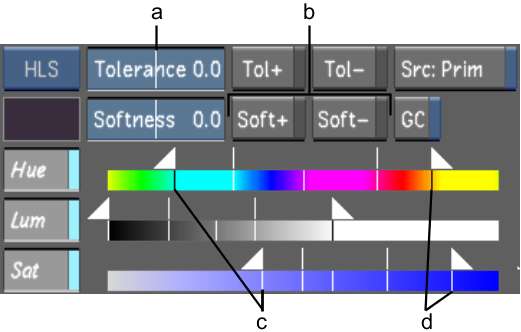Once you have set the tolerance range, you can then set the softness range. Softness sets the range of colours to make semi-transparent and can create a softer key. Use softness to create a more natural and softer look when applying secondary colour correction.
To set the softness of a key, you can use the colour picker, the Master Softness slider, or the Softness Range indicators. With the colour picker and the Master Softness slider, you set the softness range for hue, luminance, and saturation together. With the Softness Range indicators, you set the softness range for hue, luminance, and saturation individually.



(a) Master Softness slider (b) Add Softness/Remove Softness buttons (c) Minimum Softness Range indicators (d) Maximum Softness Range indicators
To set the softness range using the colour picker:
In Matte view, you can see the modifications you make to the softness. You can toggle between Matte view and Secondary view while you fine-tune a key.
To set the softness range using the Master Softness slider:
In Matte view, you can see the modifications you make to the softness. You can toggle between Matte view and Secondary view while you fine-tune a key.
When you release the slider, the softness is modified and the slider returns to its original position.
To set the softness range for the hue, luminance, or saturation channel:
In Matte view, you can see the modifications you make to the softness. You can toggle between Matte view and Secondary view while you fine-tune a key.